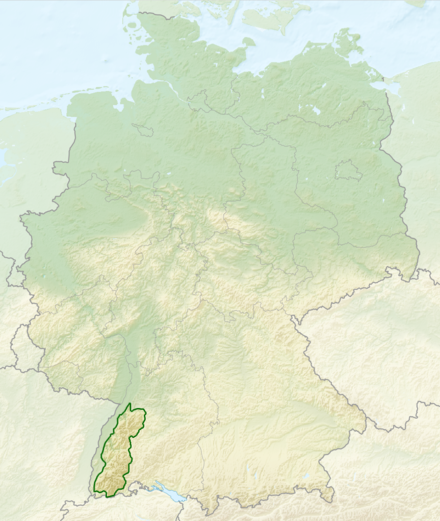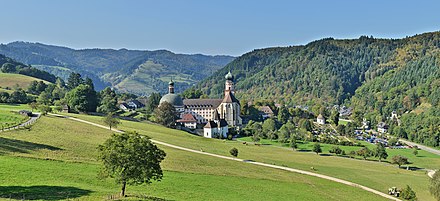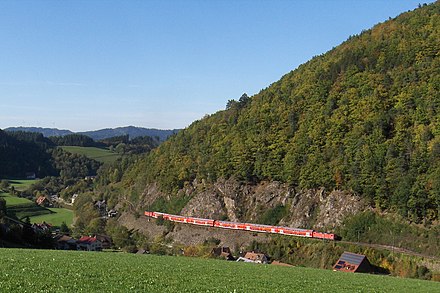 The Black Forest (dead link: January 2023) (German: Schwarzwald) is located in the southwest corner of Germany in the federal state of Baden-Württemberg, which contains the namesake low, forested mountain range and warm, sunny lowlands at its foot. It is known as one of Germany's most beautiful and favourite destinations. There is both nature and history to be found, and thanks to unique climatic conditions in the middle of the European landmass, those can be enjoyed year-round with some of the warmest temperatures in Germany.
The Black Forest (dead link: January 2023) (German: Schwarzwald) is located in the southwest corner of Germany in the federal state of Baden-Württemberg, which contains the namesake low, forested mountain range and warm, sunny lowlands at its foot. It is known as one of Germany's most beautiful and favourite destinations. There is both nature and history to be found, and thanks to unique climatic conditions in the middle of the European landmass, those can be enjoyed year-round with some of the warmest temperatures in Germany.
Understand
.jpg/440px-Gutach,_Freilichtmuseum_Vogtsbauernhof,_Vogtsbauernhof,_Ansicht_von_S%C3%BCdosten_(links_der_Speicher).jpg) This ancient forest is famous for its legends and the black fir trees that dot the landscape. While not particularly high, the mountains offer a wonderful place to go hiking or mountain biking. There are a few skiing resorts as well offering average but crowded conditions. Better to head south to the Alps if you are a serious skier or boarder.
The Black Forest is a mountainous terrain at about above sea level, the highest point being the Feldberg (the field mountain) at . The region managed by the Black Forest Tourism Board extends beyond the mountains and includes attractions like the Europa-Park and the Kaiserstuhl hills in the Upper Rhine Plain as well as the surrounding cities.
This ancient forest is famous for its legends and the black fir trees that dot the landscape. While not particularly high, the mountains offer a wonderful place to go hiking or mountain biking. There are a few skiing resorts as well offering average but crowded conditions. Better to head south to the Alps if you are a serious skier or boarder.
The Black Forest is a mountainous terrain at about above sea level, the highest point being the Feldberg (the field mountain) at . The region managed by the Black Forest Tourism Board extends beyond the mountains and includes attractions like the Europa-Park and the Kaiserstuhl hills in the Upper Rhine Plain as well as the surrounding cities.
The region is famous for its cuckoo clocks, watchmaking, skiing and hiking. There is a large high-tech light engineering industry in the region stemming from the silver-mining and watchmaking days.
The most important destination in the Schwarzwald is called, interestingly, Titisee, which is a medium-sized lake with associated tourist village (Titisee-Neustadt) and hotels, with very nice views and generally very relaxed and healthy activities. From here it is a short journey to Lake Constance and the city of Konstanz, or to see the Rhein Waterfall at Neuhausen in Switzerland.
Destinations
Cities, towns and villages
- Baden-Baden - world famous spa town
- Badenweiler
- Bad Säckingen
- Bad Wildbad
- Baiersbronn - famous for hiking and Michelin star rated restaurants
- Bonndorf im Schwarzwald - famous for its Shrovetide museum
- Calw
- Emmendingen
- Feldberg (Schwarzwald) - most important ski resort of the region, adjacent to the eponymous mountain
- Freiburg - considered the "Jewel of the Black Forest"
- Freudenstadt
- Gengenbach
- Gersbach
- Gernsbach - historic centre of the lower Murg Valley
- Gutach (Schwarzwaldbahn) - home to the Black Forest Open Air Museum and the Bollenhut headdress that has become a symbol of the Black Forest
- Häusern
- Kehl
- Laufenburg
- Lörrach
- Offenburg - the capital of the wine region Ortenau
- Pforzheim - the "Gateway to Black Forest"
- Rastatt
- Rottweil - the oldest town in Baden-Württemberg, famous for its colorful carneval festival
- Schiltach
- Schönwald Im Schwarzwald - where the cuckoo clock was invented in 1737
- St. Blasien with St. Blaise Cathedral
- Titisee-Neustadt
- Triberg Im Schwarzwald
- Villingen-Schwenningen - traditional stronghold of the Swabian-Alemannic Fastnacht
- Weil am Rhein
Other destinations
- Black Forest National Park
- Europa Park — a theme park, the largest in Germany, and the second most popular in Europe, following Disneyland Paris
- Taubergießen <span class="listing-sister-icons">
</span> — floodplain wetland next to the Rhine
- Westweg — long-distance hiking trail from Pforzheim to Basel
Get in

By plane
The only airport with scheduled services in the Black Forest region is the Baden-Airpark (IATA: FKB) near Baden-Baden. Other airports in neighbouring regions include:
- Euroairport between Basel, Switzerland and Mulhouse, France (multiple IATA codes including (IATA: EAP) - officially also serving Freiburg in the Black Forest but, in reality, 70 km away
- Bodensee-Airport of Friedrichshafen,
- Stuttgart Airport, (IATA: STR) with a number of domestic and international connections within Europe
- Frankfurt Airport, (IATA: FRA) a major international and intercontinental hub, with good fast train connections
- Zurich Airport (IATA: ZRH) in Switzerland, also well-served and well-connected
Get around
 The region is covered by regional trains and buses. As they can be infrequent, it is better to check the departure times in advance (e. g. through bahn.de or some public transport apps).
The region is covered by regional trains and buses. As they can be infrequent, it is better to check the departure times in advance (e. g. through bahn.de or some public transport apps).
If you stay in a guest house or a hotel, you will often be offered a free "Gästekarte" (guest card), called KONUS (dead link: January 2023). It allows you to go around freely in many local trains and buses (which do not include the express trains "IC/EC" and the high speed trains "ICE"). It is valid during your whole stay, from you arrival and including the day of your check-in, so it allows visiting the region by going from one accommodation to another without paying any transportation ticket. It includes the following zones (a map is available through the link above):
- Tarifverbund Ortenau
- Regio-Verkehrsverbund Freiburg
- Regio-Verkehrsverbund Lörrach
- Waldshuter Tarifverbund
- Verkehrsverbund Schwarzwald-Baar
- Verkehrsverbund Rottweil
- Verkehrsgemeinschaft Freudenstadt
- Verkehrsgesellschaft Bäderkreis Calw
- Parts of Karlsruher Verkehrsverbund You will only need to show it with a photo ID to the driver or the train staff.
See

- The city of Freiburg, a historic university city, well known as the driest, warmest, sunniest part of Germany.
- Drive on the Schwarzwaldhochstraße, a scenic road which runs through the Black Forest between Freudenstadt and Baden-Baden.
- Visit the Mummelsee, a small lake along the Hochstraße
- The Deutsches Uhrenmuseum at Furtwangen along the Schwarzwaldhochstraße, the biggest collection of Black Forest and Cuckoo clocks.
- The extraordinarily well-preserved medieval Cistercian monastery Kloster Maulbronn near Pforzheim is a UNESCO World Heritage site
Do

- Hiking
- Water sports
- High altitude lake diving
- Skiing & snowboarding (December to March in the higher regions)
- Mountain biking
- Paragliding
- Visit a medieval mine ("Schaubergwerk")
Buy
- Buy authentic "Schwarzwälder Kuckucksuhren".
Talk
Most Germans have learned some English at school, so you should be able to get by. Due to the closeness of France and the long-standing German-French treaty of friendship, French is widely taught in secondary schools, but outcomes vary widely. Tourism industry businesses like Europapark that attract significant numbers of French people will however cater to French speakers as best they can, including a Bastille Day parade. An advertisement campaign ("Wir können alles außer Hochdeutsch") poked fun at the propensity of Baden Württemberger to speak with a strong dialect, but standard German will be understood and is taught in schools.
Eat
 The food tends to be wholesome, heavy dishes and lots of cakes, biscuits, meats and gravies. Perhaps the most internationally renowned is the Schwarzwälder Kirschtorte, the Black Forest gateau, a moist chocolate cake with fermented cherries and a hearty dose of whipped cream and chocolate shavings.
The food tends to be wholesome, heavy dishes and lots of cakes, biscuits, meats and gravies. Perhaps the most internationally renowned is the Schwarzwälder Kirschtorte, the Black Forest gateau, a moist chocolate cake with fermented cherries and a hearty dose of whipped cream and chocolate shavings.
Eating out in nice restaurants can be expensive, with a meal for two cost ranging from €40 to €150 including drinks. Village inns tend to be cheaper than their counterparts in towns and cities. But bargains can be found, with many Kebab and Turkish-style pizzerias offering items under €5. Or shop at the local grocery store for fresh baguettes, meat, and cheese. Groceries are inexpensive, with a variety of fruit juices available at a reasonable price (there are cherry, apple, grape, orange, banana, even sauerkraut juice in nice tetrapak containers, a liter is under €1). In the south Schwarzwald, look for stores Lidl, Aldi, and Pennymarkt for the best food values.
The Black Forest area has a number awarded restaurants with the small village of Baiersbronn having Germany's highest density of star rated restaurants. Other notable restaurants can be found in Bühl and Freiburg.
Drink
Some of Germany's best beers and wines are produced in the region. Beer is one of Germany's top drinks and is spread widely in the Black Forest as well. Some of the most common beers are from Rothaus and Alpirsbacher.
Sleep
Accommodation in the main tourist areas may be cheaper than many of the quaint smaller towns and villages. For a nice hut at a reasonable price, look for a privately-operated Gasthaus, which can be found in villages throughout the area. There are many pleasant surprises waiting, often with excellent home-cooked food and special service, often provided by the family living there for many generations. Ask at the local Tourist Bureau for a list, often with prices. Sometimes the Tourist office will even call to ask availability.
Gasthaus rooms may be found for as low as €20 for one person, up to €70 for a double room/two persons. Reservations may be needed during festivals or summer near tourist locations. Mid-price Hotels begin at €50-100 a night per double room, with lots of availability in the mid and expensive categories.
The Black Forest area has some of the best hiking options, with well-marked trails, and maps available from the tourist offices. Some Germans even spend a week or two hiking with their backpack, with primitive lodging available in small cabins along the trails (must be reserved in advance through the Forstamt office).
Stay safe
Go next
- Bertha Benz Memorial Route - follow the tracks of the world's first return car journey back in 1888 from Pforzheim in the Black Forest to Mannheim
- Schwaben cultural region and enjoy some Spätzle egg noodles in this picturesque adjoining region that joins Baden-Württemberg with Bavaria.